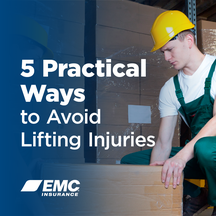- Home
- Loss Control
- Loss Control Insights
- 5 Practical Ways to Avoid Lifting Injuries
On-the-job lifting can lead to sprains and strains—especially back injuries. And while these overexertion injuries cause pain to injured employees, the average company cost of more than $32,000 per claim also causes financial pain to the companies where these injuries occur, according to National Safety Council 2016 stats.
Check out these 5 steps you can take to protect your employees and your company from on-the-job lifting injuries:
1. Recognize that the safest lift is the one employees never make
Although most lifts don’t cause injury, the continual strain on the body from frequent lifting takes a toll. Over time, these repetitive actions can contribute to reduced work quality and productivity so that even low-weight lifts repeated enough times can cause fatigue, injury and pain. A newly-injured employee may say, “I’ve been lifting that 30-pound item for 10 years and never had a problem,” and that’s exactly the point. Every lift eliminated through automation, good work design and other controls keeps workers from reaching their “breaking point.” Using tools and implementing practices that avoid both repetitive lifting and occasional heavy lifts can keep your employees working longer without injury.
2. Install easy fixes to make a big difference in lifting safety
Eliminating lifting entirely or installing expensive automated equipment may not be feasible in your workplace. Instead, seek out small changes that may have a big effect on reducing the amount of lifting. Use cost-effective aids such as lift tables, adjustable height workstations, tilting carts and hoists to keep employees from bending over, twisting at the waist or extending their arms when lifting.
Even less expensive do-it-yourself projects can solve some specific issues and make tasks less strenuous. Several examples include storing items to be moved on work tables or pallets at the employees’ waist level to prevent bending over while lifting, building a ramp to move and raise bulky objects and modifying a two-wheel cart to handle a particular item that needs frequent moving. Think creatively with your crew to come up with low- or no-cost solutions to your weighty problems.
3. Establish processes and procedures to prevent lifting injuries
In addition to adding appropriate technology to make lifting safer or eliminating lifting as much as possible, there are some processes that can minimize manual lifting injuries. Some companies that are unable to reduce or eliminate lifts require that loads greater than 50 pounds be lifted by two or more people to limit force exertion. Other organizations periodically rotate workers through jobs using different muscle groups so they aren’t stressing one body part continually. Another option is to have “floater” employees provide periodic breaks for employees with the most intense tasks. Before you can get creative in your methods, it’s necessary to evaluate what is happening in each work area and determine better ways to get the job done. Checklists and evaluation suggestions can jumpstart the process.
4. Train employees on safe lifting techniques
A good training program helps employees understand how to lift as safely as possible. Your program should offer demonstrations and practice opportunities, and should include topics such as planning the lift before taking action, and proper lifting techniques (e.g., hugging the load in close to the body and avoiding twisting and bending at the waist). Controlling the frequency of lifts is another key topic for training.
For many companies, training is the most commonly used method of preventing loss control problems. However, instructing employees on safe lifting practices doesn’t always prevent injuries because there is no safe way to lift some items. The best practice is to combine good training with tools and procedures that minimize the total number of lifts employees must make.
5. Ditch the back belts
Wearing a piece of personal protective equipment such as safety glasses, steel-toed shoes or a hard hat is an effective way to improve worker safety. Back belts are often recommended to reduce injuries. However, a study performed by NIOSH concluded that back belts should not be considered personal protective equipment and should not be recommended for on-the-job tasks. Rather than having employees wear back belts, incorporate more effective safety practices.
Get in touch
Need help? We’re here for you! Whether you have questions or need personalized assistance, your local office is ready to support you.
Loss Control Insights
Stay informed with the latest news and receive actionable safety tips, all carefully curated by our team of experts.
